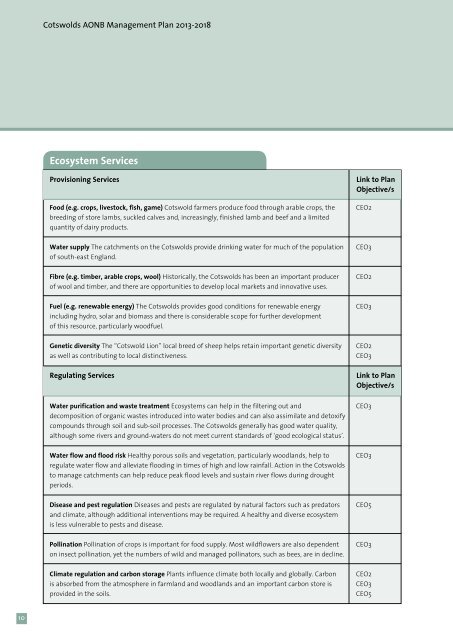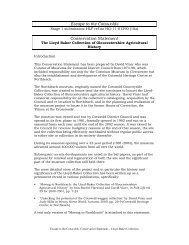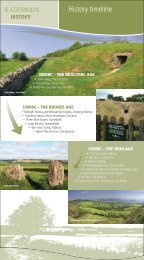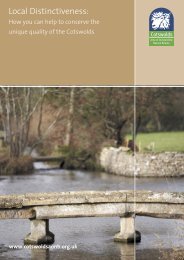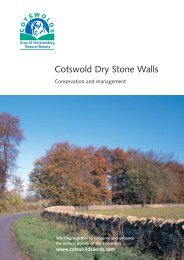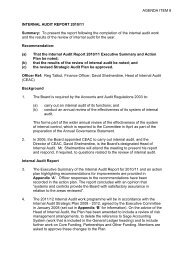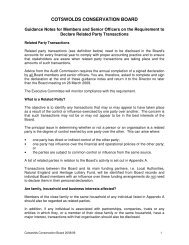Introduction - Cotswolds Area of Outstanding Natural Beauty
Introduction - Cotswolds Area of Outstanding Natural Beauty
Introduction - Cotswolds Area of Outstanding Natural Beauty
You also want an ePaper? Increase the reach of your titles
YUMPU automatically turns print PDFs into web optimized ePapers that Google loves.
<strong>Cotswolds</strong> AONB Management Plan 2013-2018<br />
Ecosystem Services<br />
Provisioning Services<br />
Food (e.g. crops, livestock, fish, game) Cotswold farmers produce food through arable crops, the<br />
breeding <strong>of</strong> store lambs, suckled calves and, increasingly, finished lamb and beef and a limited<br />
quantity <strong>of</strong> dairy products.<br />
Link to Plan<br />
Objective/s<br />
CEO2<br />
Water supply The catchments on the <strong>Cotswolds</strong> provide drinking water for much <strong>of</strong> the population<br />
<strong>of</strong> south-east England.<br />
CEO3<br />
Fibre (e.g. timber, arable crops, wool) Historically, the <strong>Cotswolds</strong> has been an important producer<br />
<strong>of</strong> wool and timber, and there are opportunities to develop local markets and innovative uses.<br />
CEO2<br />
Fuel (e.g. renewable energy) The <strong>Cotswolds</strong> provides good conditions for renewable energy<br />
including hydro, solar and biomass and there is considerable scope for further development<br />
<strong>of</strong> this resource, particularly woodfuel.<br />
CEO3<br />
Genetic diversity The “Cotswold Lion” local breed <strong>of</strong> sheep helps retain important genetic diversity<br />
as well as contributing to local distinctiveness.<br />
Regulating Services<br />
Water purification and waste treatment Ecosystems can help in the filtering out and<br />
decomposition <strong>of</strong> organic wastes introduced into water bodies and can also assimilate and detoxify<br />
compounds through soil and sub-soil processes. The <strong>Cotswolds</strong> generally has good water quality,<br />
although some rivers and ground-waters do not meet current standards <strong>of</strong> ‘good ecological status’.<br />
CEO2<br />
CEO3<br />
Link to Plan<br />
Objective/s<br />
CEO3<br />
Water flow and flood risk Healthy porous soils and vegetation, particularly woodlands, help to<br />
regulate water flow and alleviate flooding in times <strong>of</strong> high and low rainfall. Action in the <strong>Cotswolds</strong><br />
to manage catchments can help reduce peak flood levels and sustain river flows during drought<br />
periods.<br />
CEO3<br />
Disease and pest regulation Diseases and pests are regulated by natural factors such as predators<br />
and climate, although additional interventions may be required. A healthy and diverse ecosystem<br />
is less vulnerable to pests and disease.<br />
CEO5<br />
Pollination Pollination <strong>of</strong> crops is important for food supply. Most wildflowers are also dependent<br />
on insect pollination, yet the numbers <strong>of</strong> wild and managed pollinators, such as bees, are in decline.<br />
CEO3<br />
Climate regulation and carbon storage Plants influence climate both locally and globally. Carbon<br />
is absorbed from the atmosphere in farmland and woodlands and an important carbon store is<br />
provided in the soils.<br />
CEO2<br />
CEO3<br />
CEO5<br />
10


